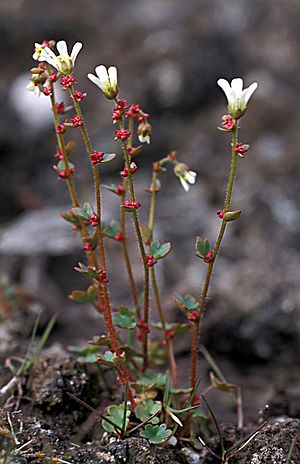Drooping saxifrage facts for kids
Quick facts for kids Drooping saxifrage |
|
|---|---|
 |
|
| Scientific classification | |
| Genus: |
Saxifraga
|
| Species: |
cernua
|
Saxifraga cernua, also known as the drooping saxifrage, nodding saxifrage, or bulblet saxifrage, is a small, beautiful flower. It's very common in the cold, northern parts of the world, especially in the Arctic. You can also find it further south in high mountains like the Alps and in countries such as Norway, Iceland, Siberia, and Alaska.
Contents
About the Drooping Saxifrage
This plant usually grows to be about 10 to 20 centimeters tall. That's roughly the length of a pencil! Its stem has about 3 to 7 leaves. The leaves near the bottom are shaped like kidneys and have 3 to 5 rounded parts. They grow on long stalks.
The flowers are usually single, meaning one flower per stem. They are white and much longer than the green parts that hold them, called sepals.
How It Reproduces
The drooping saxifrage has a special way of making new plants. It grows small, brownish-red parts called bulbils. These bulbils grow where the upper leaves meet the stem. They are like tiny plant babies that can drop off and start growing into new plants. This helps the plant spread easily.
Where It Grows
You can find this plant growing in places that are moist and sandy. It also likes mossy areas, on rocky ledges, and in spots where snow stays for a long time. These are often cold, damp environments.
Protecting This Plant
Because of its unique nature and habitat, the drooping saxifrage is a protected species in some areas. For example, in the United Kingdom, it became a protected plant in 1975. This was done under a special law called the Conservation of Wild Creatures and Wild Plants Act. This law helps make sure that important plants like the drooping saxifrage are kept safe.
See also
 In Spanish: Saxifraga cernua para niños
In Spanish: Saxifraga cernua para niños

